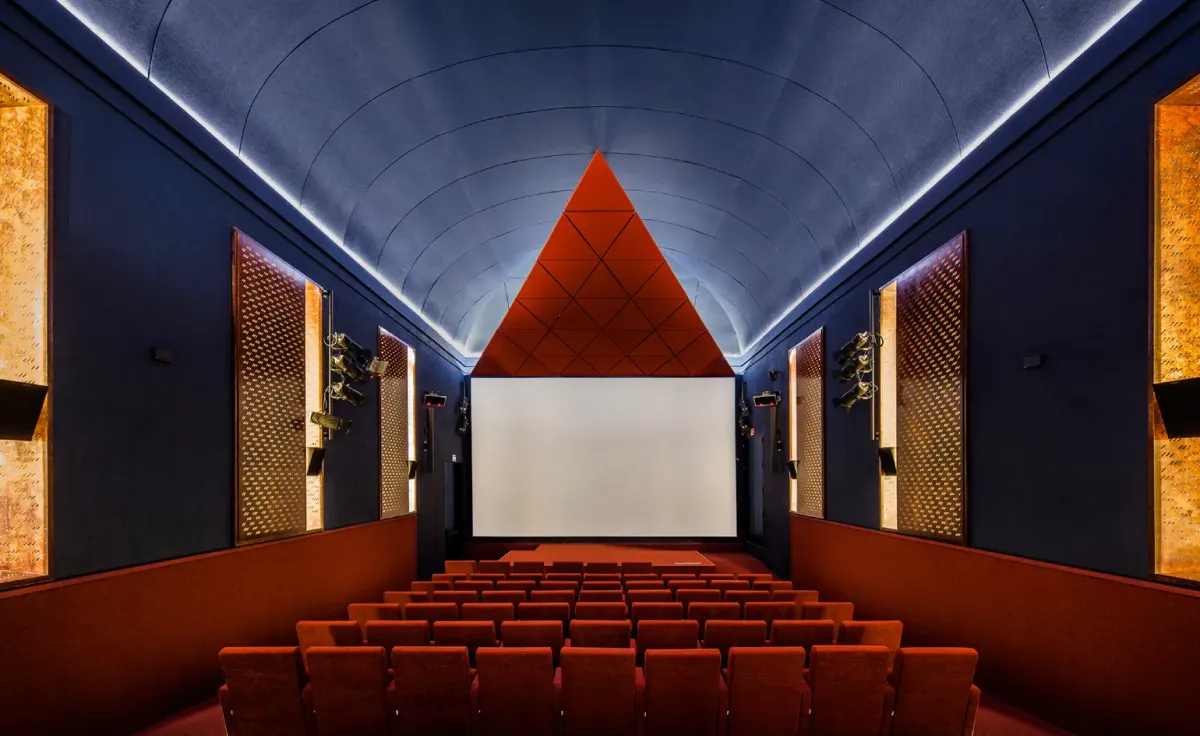
tl;dr
- Museo Reina Sofía recently unveiled a new cinema in its underground auditorium.
- The project for repurposing the underground auditorium into a cinema was executed by the Catalan architectural design bureau Bach Arquitectes.
- While maintaining the original elements of the auditorium, the new redesign integrates them into a layout imbued with the atmospheric spirit of the great surrealist directors.
Museo Reina Sofía, Spain's national museum dedicated to 20th century Spanish art, recently unveiled a new cinema in its underground auditorium. The project for repurposing the underground Sabatini auditorium into a cinema was executed by the Catalan architectural design bureau Bach Arquitectes. Located in a former 18th-century hospital designed by the renowned architects José de Hermosilla Sandoval and Francisco Sabatini, the museum is a fundamental pillar of the Spanish capital's Golden Triangle of Art.
Prior to the opening of Museo Reina Sofía in 1992, the old hospital building where it is housed underwent a thorough reconstruction and redesign that lasted several years. The Catalan architects, Jaume Bach and Gabriel Mora, were invited to reimagine the auditorium underneath the Sabatini building in 1987. Now, almost four decades later, the architectural studio has returned to participate in a new build in this space, under the supervision of Eugeni and Anna Bach. While maintaining the original elements of the auditorium, the new redesign integrates them into a layout imbued with the atmospheric spirit of the great surrealist directors, from Luis Buñuel to David Lynch.
The design of the new cinema incorporates several elements that rejuvenate the long, vaulted hall, and skate a fine line between historic memory and surrealist vision. The Serlian entrance to the hall is decked out in sumptuous velvet curtains that conceal the triangular projection hub; the cinema's seats and carpeting have been refurbished in red velvet, while the vaulted ceiling and walls have been painted in a deep blue evoking the sky, lending the whole ensemble the sensation of being outside despite being underground. Able to seat up to 133 spectators, the slope of the hall has been adjusted for an optimal viewing experience, with improved acoustics and access for disabled individuals. The projection hub houses equipment which allows for digital projections, the screening of 16mm and 35mm films, and provides immersive 5.1 audio.

The transformation of the auditorium into a space devoted to moving images was initiated two years ago by the museum's new director, Manuel Segade, whose vision for the institution involves expanding its horizons towards the performing arts, music and cinema, reconceptualizing it as a “polyphonic institution, capable of generating an ecosystem, not a hegemony.” The museum is already the second-most visited art institution in the capital and, with the opening of its new cinema, aims to further enhance its prominence and importance to the city's cultural life. The design of the interior establishes a meaningful cultural tie with the city's other iconic cinemas, such as the Cinema Doré, the Cineteca and the Sala Equis.
The newly inaugurated subterranean cinema has been placed under the supervision of Chema González, the director of the Museum's Department of Cinema and New Media, who has organized a screening program throughout the whole of November titled Cine, año cero, which is featuring a program of films ranging from Tsai Ming-liang's Goodbye, Dragon Inn, a series dedicated to Ira Sachs, and a retrospective of works by MetaHaven. Screenings at the cinema run from Thursday to Sunday, with an impressive lineup of works included on the museum's calendar.
Museo Reina Sofía houses a massive collection comprising over 25,000 artworks, spanning the period from the final decades of the 19th century to the present day. The collection includes seminal pieces by such artists as Pablo Picasso, Salvador Dalí, Joan Miró and Pablo Serrano, but also works by international artists, including Vasily Kandinsky, Francis Bacon, Marko Rothko, Pierre Bonnard, Nam June Paik and Max Ernst. Visit the Museum website to find out more about its collection and the cinema's screening program.
